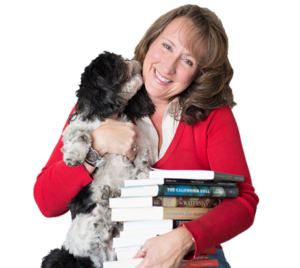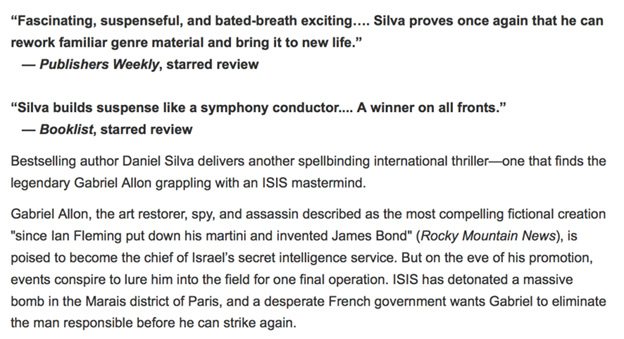 by Penny Sansevieri
by Penny Sansevieri
No matter which site you’re using to sell your books, book descriptions are more important to sales than most authors realize. Many times, I’ll see blocks of text, pulled from the back cover of the book, used as promotion. Although that’s not a bad idea, you’ll want to make sure that the description you’ve chosen is powerful, and also keep an eye on formatting—things like spacing, bulleting, and using a bold typeface.
Since I primary focus on Amazon, this article will tell you how to maximize your book-description efforts specifically on that e-tailer, but you’ll likely find many of the ideas relate to other e-tailers as well.
Book Descriptions Should Be Meaningful, Whether Scanned or Read Word for Word
Most people don’t read websites, they scan them. The same is true for your book description. If you have huge blocks of text without any consideration for spacing, bolding, bullets, or some other form of highlighting that helps the reader scan, it can be a problem. It’s much more visually enticing if you employ strategic formatting to highlight certain points and ideas, and psychologically it invites the reader to delve into the text instead of navigating away from it.
Our minds are image processors, not text processors, so huge pieces of text that fill a page overwhelm the mind, and in fact, considerably slow down the reader’s absorption time. When you’re looking at websites, your attention span is shorter than it is while reading a book. Especially on shopping sites like Amazon, it’s important to keep in mind that most potential readers will move on if your text is too cumbersome. So how can you make your descriptions more scan-friendly?
- Headlines: The first sentence in the description should be a grabber, something that really pulls the reader in. This text could also be a stunning blurb or some other kind of endorsement, but regardless, it should be bolded. If you’re looking at your Amazon book page, you could also use the “Amazon Orange” to set this sentence apart from the rest of the text.
- Paragraphs: Keep paragraphs short, 2-3 sentences max.
- Bolding: You can bold key text throughout the description. In fact, I recommend it. Just be sure you aren’t bolding too much. Don’t grab 2-3 sentences to bold, because it’ll have more impact if you bold one or just a few keywords.
- Bullets: If your book is nonfiction, it’s a good idea to bullet your information as much as you can. Take central points and the “here’s what you’ll learn” elements and put them into a bullet-point section that’s easy to scan and visually appealing.
Here are some of the coding enhancers available from within Amazon’s Author Central that you can use to add emphasis to text:
- Bolding: <b>The text you want bolded</b>
- Italics: <i>The text you want italicized</i>
- Headline: <h1>The text you want for a headline</h1>
- Amazon Orange Headline: <h2>The text you want bolded</h2>
You can add numbered lists and bullet points, too.
Readers’ Biggest?: “What’s In It For Me?” – Fiction vs. Nonfiction
The biggest challenge authors face is writing a compelling book description that shows readers how and why the book will benefit them. This is a critical part of any book description, whether fiction or nonfiction. Remember, with 4,500 books published every day in this country, you can’t afford to have a vague book description. You must state clearly why this book is the best one they can buy. Here are some things to consider:
- Nonfiction: Your target audience often has access to ten or more titles similar to yours. As you’re crafting your book description, keep in mind that you should hook readers from the first sentence, and remember to make a personal connection with them. If your bio is compelling, you can add a statement about your expertise, but keep it brief, because you’ll have a chance to elaborate on it later.
- Fiction: Here it’s best to focus on the elevator pitch, because that’s going to be your cliffhanger. When it comes to fiction, buyers have a lot of options, so be clear on what your book is about, and lead with the hook without revealing too much of the story.
- Children’s and/or Young Adult Titles: Make sure to include the intended age range. Even though you can add it in the Amazon details, parents (and teachers) say that seeing it in the book description is incredibly helpful.
Don’t Market to Your Own Ego
The second prong of showing readers what’s in it for them is not appealing to your own interest. I often tell authors that no one cares that you wrote a book. And while family and friends may care, they aren’t your intended audience. This is partially why I recommend that authors never write their own book description. I often hire someone to do this for me because I’m just too close to it to see what may really matter to my reader.
Your Elevator Pitch – What Is It & Why Do You Need One?
It’s a short one or two sentence description about the book. With our ever-shrinking attention spans, you’ll need to capture someone’s focus in a very short, succinct pitch. Including this same short blurb in your book description is an excellent way to start building your pitch outward from the one element that your book could not exist without, and that will be the biggest piece that matters to your reader.
Keep Your Language Simple
Save your five-dollar words for another time. The best book descriptions uses simple language that any layperson can understand. If you make readers think about a word, you’ll lose them.
How Excited Are You? How Excited Will Your Readers Be?
Have you ever seen a book description with a ton of exclamation points or caps? Much like in email, it feels as if someone is screaming at you. While exclamation points can be included in a book description, they should be used sparingly. In terms of caps, don’t even bother. Caps in a book description make you look like an amateur.
Spellcheck
It goes without saying, but still, I’ve seen it often enough that I feel I need to say it. Please don’t put up a book description full of typos. Even one is too many.
Is Your Book Part of a Series?
If your book is a series, make it obvious in the headline. I also recommend that you make it part of the title, too. For example, you might word your book title like this: Deadly Heat: Heat Series Book Four of Seven.
Here’s an example of how Dan Silva does it:
 The reason for this is that readers (especially readers of fiction) love a series, so tell them right up front that your book is part of the same or similar story.
The reason for this is that readers (especially readers of fiction) love a series, so tell them right up front that your book is part of the same or similar story.
Include Top Keywords
Keywords are as important to your Amazon book page as almost anything else. Here is a quick overview:
The term “keyword” is actually inaccurate, because readers don’t search using a single keyword. Think instead of keyword strings. So, for example, “romance about second chances” has been a popular search string on Amazon for a while now. By inserting that phrase into your book description, you can boost your visibility on the site as well as hook directly into your readers’ interest. So if they’re searching for “romance about second chances” and they see it in the book description, they are going to be more excited about your book. That said, it’s a good idea to avoid over-stuffing your book description with keywords. I recommend finding six or seven strings and using them sparingly.
Tailor Your Bio to Your Book
One of the things that I see a lot is author bio information that has nothing to do with the book. For example, let’s say you wrote a book about marriage, but your bio talks about how you live in Maine with your wife and three dogs. That doesn’t help substantiate your expertise for writing this book. The same is also true for fiction. If you have multiple books, mention that; if you have a fun or quirky writing habit, mention that, too. It’s a good idea to personalize this for your audience and the market. List any credentials related to the book topic and/or any research you’ve done. Most of all, make it interesting and keep it short. Long, boring author bios don’t sell books.
Include Quotes and Reviews
When authors share reviews, you’ll often see quotations like “This is the best mystery book I’ve read in ages!” but the name of the reviewer is omitted. Reviews and quotations/blurbs are fantastic to use in your book description, but only if they are credited appropriately. If you believe the name won’t lend the kind of credibility that you want from the blurb, consider asking the person to review the book and post it.
Update Your Page Often
Here’s something you may not have considered: your page doesn’t have to be static; in fact, ideally it shouldn’t be. As you get blurbs and awards, update your book page by including them. And here’s an idea: if you’re doing a special promotion (book promo, discount, whatever), why not mention that in your book description?

Finally, take a look at this book description, again from Dan Silva. It’s a great example of book promotion that combines great blurbs with a book description that pulls you in from the first sentence. Book blurbs are eye candy; i.e. people like what other people like. Even if you don’t have blurbs by highly recognizable names such as Booklist and Publishers Weekly, you should add them; just be sure to cite them correctly. Notice how they are bolded to draw attention to them? And check out the second paragraph. Whoever wrote this book description inserted a review to help bolster the character description, which is another great idea.
 Book descriptions, whether on Amazon, iTunes, or Barnes & Noble, are your sales page. Ultimately they are what will, or won’t, help sell your book, so make sure they’re tightly written, exceptionally engaging, and most of all, turn a browser into a buyer.
Book descriptions, whether on Amazon, iTunes, or Barnes & Noble, are your sales page. Ultimately they are what will, or won’t, help sell your book, so make sure they’re tightly written, exceptionally engaging, and most of all, turn a browser into a buyer.
Penny Sansevieri, CEO and founder of Author Marketing Experts, Inc. (AME) and an adjunct professor at NYU, is a best-selling author and internationally recognized book marketing and media relations expert. Her company is one of the leaders in the publishing industry and has developed some of the most cutting-edge book marketing campaigns.
